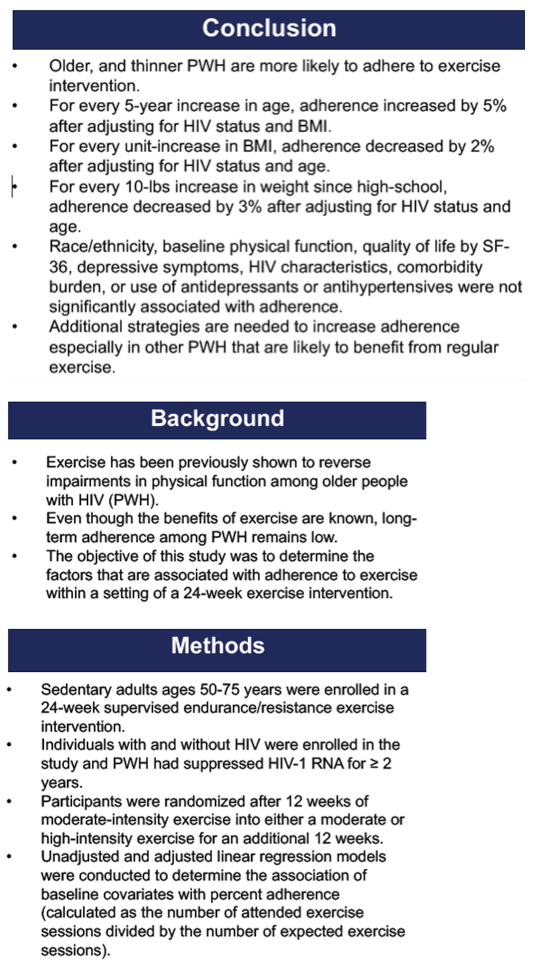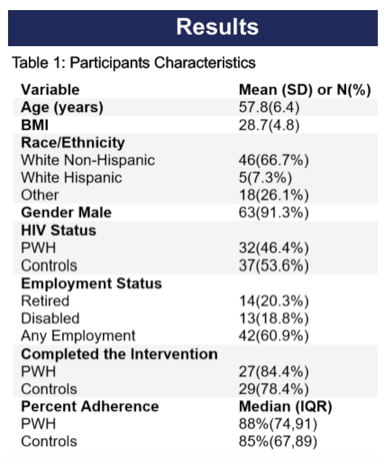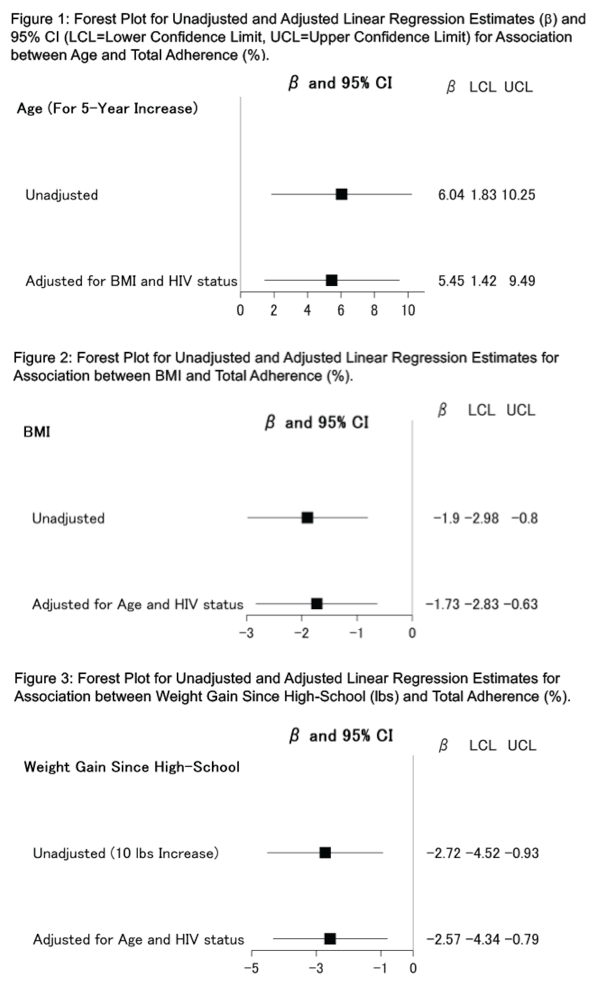 |
 |
 |
| |
Characteristics Associated with Exercise Adherence in
the Setting of a Supervised Intervention
|
| |
| |
10th International Workshop on HIV and Aging, October 10-11, 2019, New York
Reported by Jules Levin
Mona Abdo MPH1, Samantha MaWhinney ScD1, Melissa Wilson MS1, Catherine Jankowski PhD2,
Kristine M. Erlandson MD MS3
1. University of Colorado School of Public Health, 2. University of Colorado College of Nursing,
3. University of Colorado School of Medicine
Program abstract
Background: We have previously shown that exercise is an effective intervention to reverse impairments in physical function among older people with HIV (PWH). Despite the known benefits of exercise, however, long-term adherence remains low. Here we explored factors associated with adherence to exercise within the setting of a 24-week exercise intervention.
Methods: Sedentary adults (50-75 years) with or without HIV enrolled in a 24-week supervised endurance/resistance exercise intervention. PWH had suppressed HIV-1 RNA for ≥ 2 years. After 12 weeks of moderate-intensity exercise, participants were randomized to continue moderate- or advance to high-intensity exercise for an additional 12 weeks. Adherence to the intervention was calculated as the number of attended exercise sessions divided by the number of expected exercise sessions. Linear regression models were used to determine the effect of baseline covariates (demographics, HIV characteristics among those with HIV, physical function/frailty, and comorbidity count, quality of life [SF-36], or depressive symptoms [CES-D]) on adherence; bivariate models were adjusted singly for age, BMI, and HIV status, as relevant.
Results: Among 32 PLWH and 37 controls, 27 PWH and 29 controls completed the intervention. The overall median adherence was 88% (IQR=74, 91) among PWH and 85% (67, 89) among controls. The mean age was 57.8 (SD 6.4) and BMI 28.7 (4.8), the majority of participants were male (91%), white (74%) and non-Hispanic (83%). Neither sex (females vs males) (β=-17.2%; 95% confidence interval -36.8, 2.5; p=0.09), HIV serostatus (3.4%; -8.0, 14.7; p=0.55), nor exercise intensity (moderate vs high) was significantly associated with adherence (3.1%; -3.1, 9.3; p=0.32). Each 5-year increase in age was associated with 6.0% (1.8, 10.3; p=0.006) greater adherence, which remained significant after adjusting for HIV serostatus (6.4%; 2.1, 10.6; p=0.004) or BMI (5.4%; 1.5, 9.3; p=0.008). Each 1 unit greater BMI was associated with 1.9% lower adherence (-3.0, -0.8; p<0.001), and remained significant after adjusting for age and HIV serostatus (-1.7%; -2.8, -0.6; p=0.003).
Similarly, for every 10 pound increase in body weight since high school, adherence decreased by 2.7% (-4.5, -0.9; p=0.004). Race/ethnicity, baseline physical function, quality of life by SF-36, depressive symptoms, HIV characteristics, comorbidity burden, or use of antidepressants or antihypertensives were not significantly associated with adherence. In contrast, participants on antipsychotic medications had 20% lower adherence compared to nonusers (-38.6, -2.3; p=0.028), with a greater difference after adjusting for HIV serostatus (-25.8%; -45.1, -6.6; p=0.009) but attenuated and no longer significant after adjusting for age (-15.6%, -33.5, 2.3; p=0.09).
Conclusions: PWH of older age and lower BMI are more likely to adhere to an exercise intervention. Additional strategies are needed to better engage and promote adherence in other PWH that are at high risk of nonadherence but likely to benefit from regular exercise.



|
| |
|
 |
 |
|
|